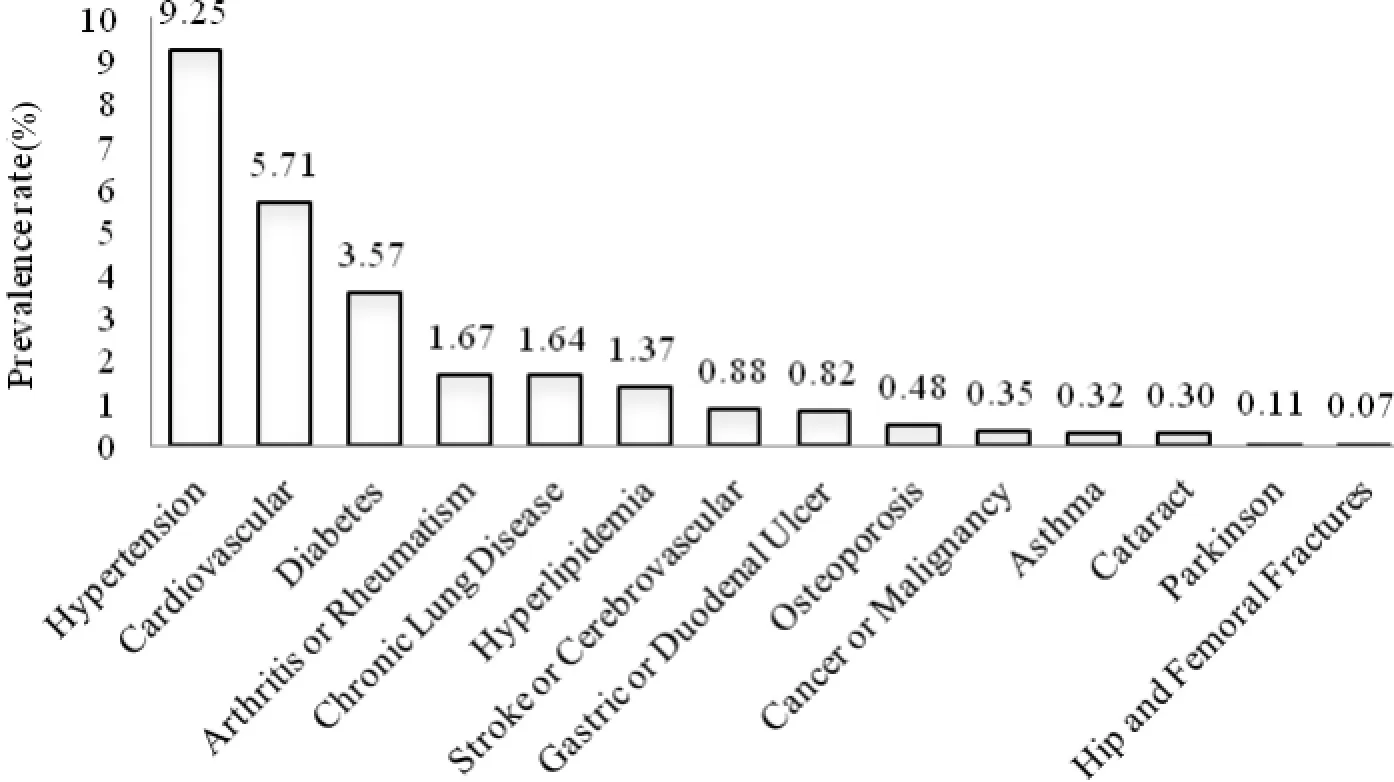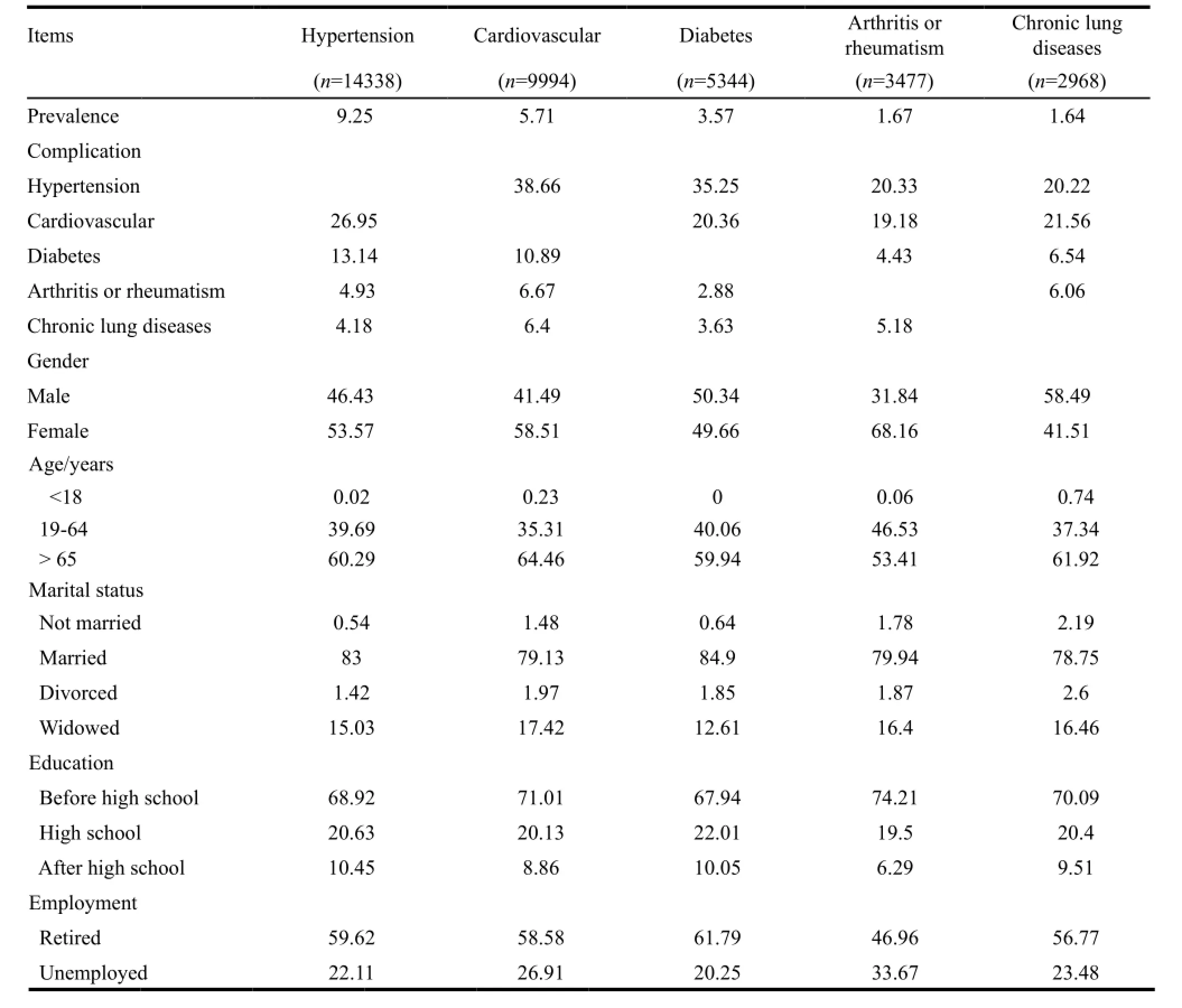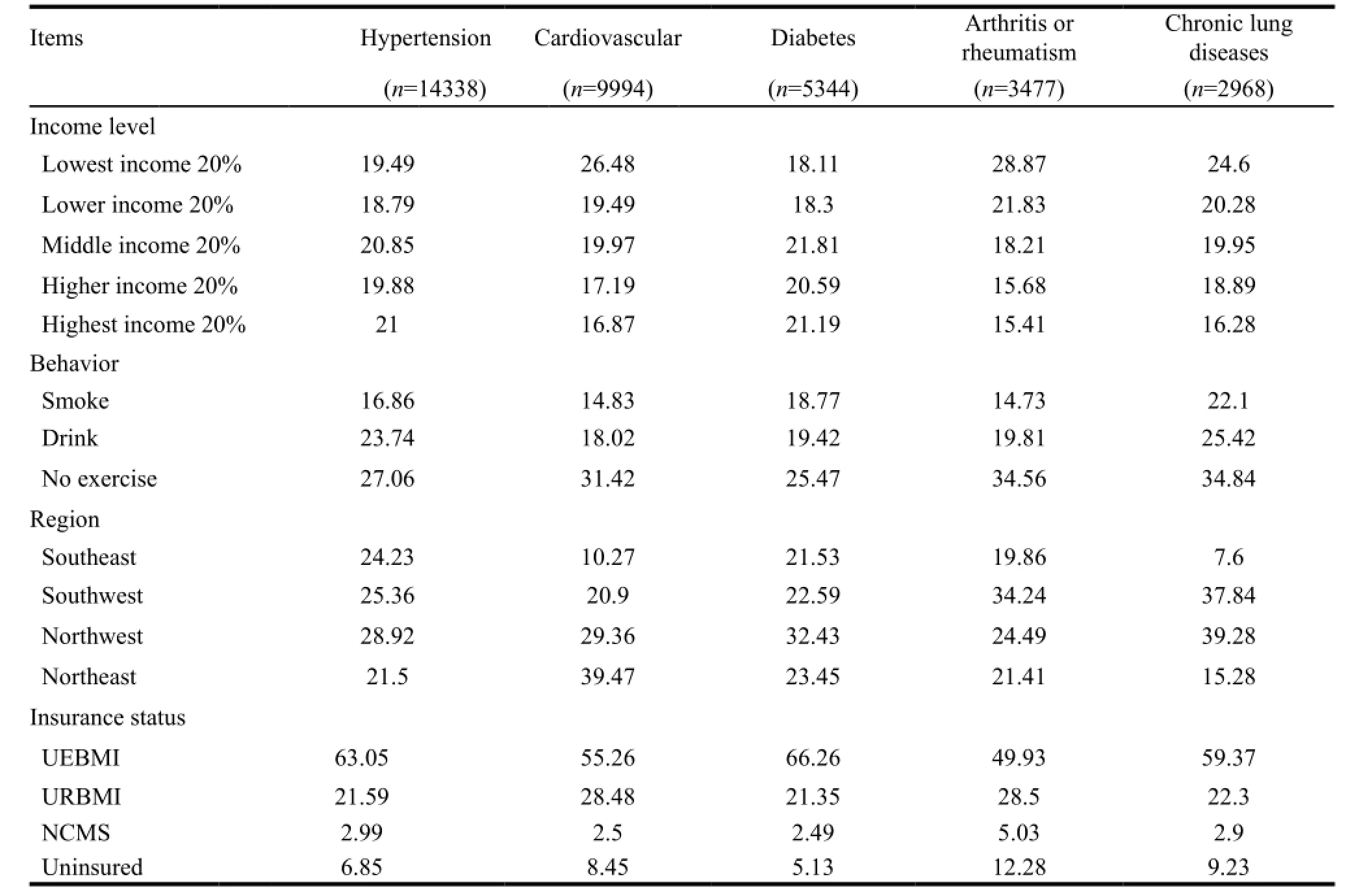Family Economic Risk Caused by Five Major Chronic Diseases among Urban Residents: A Comparative Study Based on the Data from 9 Cities in China
2014-05-15LIUMingSUNLihua
LIU Ming, SUN Li-hua
(School of Business Administration, Shenyang Pharmaceutical University, Shenyang 110016,China)
Family Economic Risk Caused by Five Major Chronic Diseases among Urban Residents: A Comparative Study Based on the Data from 9 Cities in China
LIU Ming, SUN Li-hua
(School of Business Administration, Shenyang Pharmaceutical University, Shenyang 110016,China)
Objective To provide evidence of family economic risk caused by five major chronic diseases for medical insurance and health policy making. Methods The adjusted RR values of relative economic risk were applied to compare the family economic risks caused by five major chronic diseases. Results and Conclusion Among sample groups with five major chronic diseases respectively, those with cardiovascular disease have the highest family economic risk, which is 2.4 times than the average. Hypertensive people is 1.7 times, which has the lowest risk. People with chronic lung disease are 2.3 times, the diabetic people are 2.1 times, and people with arthritis or rheumatism are 2.0 times. Medical insurance should increase the proportion of reimbursement to reduce the medical expenditure for people who have high family economic risk caused by chronic diseases.
urban resident; chronic disease; family economic risk; adjusted RR value
1 Introduction
With the changes of people’s life and working style, together with the strong influence from nutrition revolution, environmental changes and aging problem, the disease that Chinese people suffer has undergone huge changes. For example, contagious and chronic diseases in the rural areas cause double burden to the residents, and in cities people mainly suffer from chronic diseases.
Though chronic diseases do not cost as fast as some acute diseases which take away the patients’ money quickly and lead to poverty, they will gradually damage patients’ability to make money within a long period and consume their families’ resources which lower their living quality, and further leads to the family economic risks.
Financial risks attributable to illness not only contain costs in healthcare services, but also the loss caused by low supply of labors and the decline of productivity, and the time loss and opportunity cost due to patients caring[1]. This kind of economic risk basically originates from uncertainty of diseases. Van Damme W[2]pointed out that family usually provides medical services through different ways, such as loans, the sale of productive assets or reducing investment in the future for the need of survival, which will undoubtedly bring risks to the family’s future economic benefits. LUO Wu-jin[3]and other people believed, in his literal review, that economic risks due to illness refers to the possibility of economic loss caused by diseases either at present or in the future. According to XU Cheng’s research[4], there were two kinds of definitions for economic risks. The risks in a broad sense contain three aspects: (1) the occurrence possibility of specific diseases; (2) the cost of medical services for specific diseases (cost loss caused by economic risks); (3) the economic pressure that people must undertake with the medical risks and economic loss (the economic risks are determined by both risk probability and loss amount); while the narrow sense of risks refer to medical expenses generated from diseases. In his research, the medical expenses are adopted to evaluate the economic risks.
Economic risk caused by illness in this research also refers to the narrow sense of economic risk. That is to say, the direct expenses paid by chronic patients and their families will lead to economic loss, which is used to evaluate the economic risk of chronic diseases. Evidences of different families with chronic patients are provided for making policies of medical insurance and healthcare, so thelimited health resources can be distributed rationally for the chronic diseases.
2 Research data and methodology
2.1 Data
The data used in this research originated from investigations in pilot places for Chinese urban residents’medical insurance in China Center for Health Economic Research of Peking University (CCHER). It included fiveyear data from the survey of 2007-2011, and it gathered 157004 individuals in total. The survey mainly contained the information of social demographic characteristics, health status, demand for medical service and utilization of medical service, medical expenses, insurance and family economies. In the 79 pilot cities, after clustering seven index which included GDP per capita, urban population, funding amount per capita, urban workers’ annual payment of medical insurances, population density, number of hospital beds and doctors per capita, etc, 9 representative cities were selected at random. The 9 cities were Baotou of Inner Mongolian Autonomous Region, Changde of Hunan Province, Chengdu of Sichuan Province, Jilin of Jilin Province, Shaoxing of Zhejiang Province, Urumqi of XinJiang Uygur Autonomous Region, Xiamen of Fujian Province, Xining of Qinghai Province and Zibo of Shandong Province.

2.2 Methodology
RR (relative risks) and the adjusted RR are used for family economic risks of chronic patients which were illustrated by HAO Mo, et al, in 1997[5]and WANG Zhifeng, et al[6,7]. It is defined as:
The value of RR reflects the extent of medical economic risks of target patients. RR value actually reflects the conception of Gini Coefficient, which means that certain percentage of people should undertake certain percentage of expenses from the view of equal capital distribution. Otherwise, it will be unequal for patients and there are some differences in economic risks. Thus, it can be used not only to compare the economic risks for specific group of people, but also to reflect the distribution of certain people’s economic risks after grouping them based on some proportion. In order to eliminate the influence of economic revenue on RR, the adjusted RR is introduced so that it can successfully show the economic risks of different groups of people. Take “observation of pure revenue per capita or specific group of people” as the regulation index, if the specific people’s revenue is lower than the observed people, the index is more than 1 and the adjusted RR values are more than the value of RR. This demonstrates that the lowincome people’s capacity to pay is far less than those with high income when the medical expenses per capita are equal.
The specific group of people chosen in this paper refers to the chronic patients, and the others refer to all the sample population surveyed among urban residents. If RR values are more than 1, the economic risks of the patient go beyond the average level; otherwise, risks are less than average if RR values are less than 1. Hence, we get the difference of economic risks of chronic patients.
3 Results
3.1 The major chronic patients among Chinese urban residents and their social demographic characteristics
Among surveyed Chinese citizens, there were 36650 people suffering from chronic diseases, and the prevalence rate was 23.34%. 63.76% of people suffered from one of chronic diseases and 36.24% of people suffered from 2 or more diseases. According to the data calculated based on the major chronic ones, we got the prevalence rate of diseases ranked in the top five, they were shown in Figure 1, hypertension, cardiovascular diseases, diabetes, arthritis or rheumatism and chronic lung conditions. The highest disease prevalence was hypertension of 9.13%. According to the percentage of complication, patients with hypertension and cardiovascular suffer more from complication. And the percentage was 38.66% and 35.32% respectively. (See Table 1)

Figure 1 Prevalence rate of major chronic diseases among urban residents in China

Table 1 Characteristic of urban residents with the five chronic diseases in China (%)

Continued Table 1
According to the data of Table 1, women who suffered from arthritis or rheumatism took account of 68.16% and it ranked first, while the percentage of men suffering from chronic lung problems was higher than other chronic diseases (P-value lower than 0.01). Smoking habits had a great impact on this disease. From Table 1 we can see that patients who smoke suffered more from chronic lung conditions than other diseases (P<0.01), and it took account of 22.1%. More than 50% of patients suffering from chronic diseases were over 65 years old and more than 80% were in the state of unemployed and retirees which was in consistent with China’s aging population. In education, those who graduated from high school or lower took account of 70%; while patients with chronic diseases had similar marriage situation. About 80% of married people suffered from chronic diseases. Sorting five levels of all the surveyed urban residents’ revenues, we found that the percentage of patients with hypertension and diabetes grew with the increase of revenue, while other three chronic diseases displayed an opposite tendency. In order to compare different areas, we divide our regions based on eight cities’ geography among nine surveyed cities. They are Shaoxing and Xiamen (southeastern area), Chengdu and Changde (southwestern area), Xining and Urumqi (northwestern area), Baotou and Jilin (northeastern area). According to the distribution of the patients who suffered from five chronic diseases, those with hypertension, diabetes and chronic lung problems rank first in northwestern areas, those with arthritis or rheumatism rank first in southwestern areas, and cardiovascular problems were in the first row in northeastern areas, while in southeastern areas patients with these problems, except for hypertension, had the smallest number. As for living habits, patients with chronic lung problems rank higher among “smoking”, “drinking”and “never exercising”. As for patients’ insurances, more than 50% of chronic patients had urban residents’ medical insurances, and the percentage of patients with arthritis or rheumatism who did not have insurance was higher than others, taking up 12.28% (P<0.01). This proportion has a big gap with the average medical insurance coverage rate of 95% in China.
3.2 The comparison between family economic risks of urban patients with five chronic diseases
Relative risk value (RR) and the adjusted RR are used for the judgment of major chronic patients’ family economic risks. The economic risks are mainly influenced by average family revenue and family healthcare expenses. As shown in Table 2, the urban residents’ average revenues of the sample population are much higher than those with five diseases and the average healthcare expense is the lowest. Patients with chronic diseases are ranked according to the amount of average healthcare expense: diabetes, hypertension, chronic lung problems, cardiovascular diseases and arthritis or rheumatism. Chronic patients are ranked according to average healthcare expense, which are sequenced as diabetes, cardiovascular diseases, chronic lung problems, hypertension and arthritis or rheumatism. As for the adjusted RR of chronic patients’ family, cardiovascular diseases are the highest with 2.4, and then it is followed by chronic lung conditions with 2.3, diabetes is 2.1, arthritis or rheumatism is 2.0 and hypertension is 1.7.

Table 2 Family economic risk of urban residents with the five chronic diseases in China
4 Conclusion and discussions
Among the chronic patients, the retirees and elderly take account of the largest proportion, especially in northwestern areas. More than 50% of the patients are retirees over 65 years old in this paper. The majority of patients have urban residents’ medical insurances. These chronic diseases have a close correlation with the acceleration of China’s urbanization and aging process. It is apparently different in various regions where chronic patients are. The number of patients in southeastern areas is the smallest, while in southwestern areas it is clear that patients suffer more from arthritis or rheumatism; in northeastern areas, cardiovascular problems rank the first and in northwestern areas, most of patients suffer from hypertension, diabetes and chronic lung problems. All in all, patients in western areas suffer all of the five diseases.
The patients’ family economic risks from five major chronic among sample population, the risk from cardiovascular patients is the highest which is as much as 2.4 times than all of other risks among the sample population. While the risk from hypertension patients has the minimum of 1.7 times, chronic lung conditions is 2.3 times, diabetes patients is 2.1 times, and the risk from patients with arthritis or rheumatism is 2 times. The average family revenues from patients with cardiovascular ranks next-to-last among the five diseases, but their healthcare expense ranks the second. Medical insurances should contribute more to the chronic patients with relatively higher economic risks in the future by enhancing the reimbursement level and reducing its base line of reimbursement. Reducing the payment of absolute medical expense and relative co-payment of chronic patients with high economic risks will help release the burden of those families and promote social equality.
[1] Pradhan M, Prescott N. Social Risk Management Options for Medical Care in Indonesia [J]. Health Economics, 2002, 11 (5): 431-446.
[2] Van D W, Van LL, Por I, et al. Out-of-pocket Health Expenditure and Debt in Poor Households: Evidence from Cambodia [J]. Trop Med Tnt Health, 2004, 9 (2): 273-280.
[3] LUO Wu-jin, Lv Zhen, Xiang li, et al. Summary of the Substance and Evaluation of Illness Economic Risk [J]. China Health Economics, 2011, 30 (5): 60-62.
[4] XU Cheng. Research on Disease Economic Risk and Risk Sharing Mode among Senior Citizens in Impoverished Families in Rural Areas [D]. Huazhong University of Science and Technology, 2007: 8.
[5] HAO Mo, DING Xiao-cang, LUO li, et al. The Method and Meanings of Measuring Rural Residents’ Illness Economic Risk [J].China Primary Health Care, 1997, 11 (10): 17-18.
[6] WANG Zhi-feng, YIN Ai-tian, HAO Mo, et al. Measuring Hospitalization Economic Risk in Primary Hospitals of Rural Residents [J]. China Primary Health Care, 1997, 11 (10): 23-25.
[7] YIN Ai-tian, LIU Yong-qiang, WANG Wei-wei, et al. Analysis of Family Illness Economic Risk of Rural Chronic Residents [J]. Health Economics Research, 2006, (12): 14-16.
Author’s information: SUN Li-hua, Professor. Major research area: Pharmacoeconomics. Tel: 024-23986553, E-mail: slh-3632@163.com
杂志排行
亚洲社会药学杂志的其它文章
- Marine Pharmaceutical Industry Development in Developed Countries and Its Enlightenment
- Study on the Establishment of Efficiency Evaluation System of Drug Supervision and Sampling Test
- New Version of GDP in EU and Its Enlightenment
- FDA Practices: GMP Quality System Inspection and Evaluation
- Three Therapeutic Regimens in Treatment of Community-acquired Pneumonia: A Cost-effectiveness Analysis
- Pharmacovigilance System for Pharmaceutical Enterprises in EU: Regulation and Its Enlightenment
